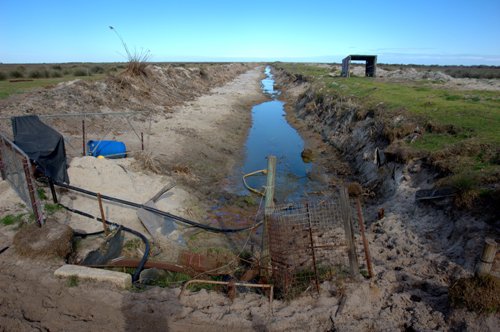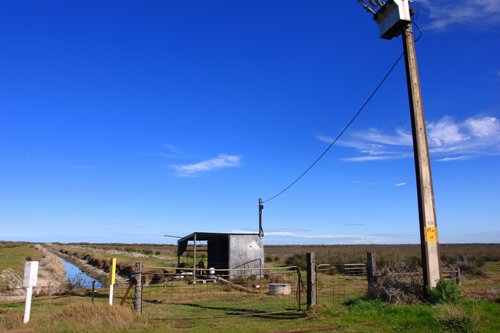|
August 21, 2008
Like myself local photographer Michael Buddle is also photographing the decline in the River Murray's lower lakes. He has informed me that the Natural Resources Centre in Strathalbyn in South Australia has copies of Terry Sim and Kerri Muller's "A Fresh History of the Lakes: Wellington to the Murray Mouth, 1800s to 1935.
The Strathalbyn Natural Resources Centre originated from staff partnerships with groups such as River Murray Catchment Water Management Board, Landcare, Goolwa to Wellington Local Action Planning Association, Land Management Program and the Angas River Catchment Group, and the text was published by the now defunct River Murray Catchment Water Management Board. Defunct due to the introduction of integrated natural resource management across South Australia.
 Gary Sauer-Thompson, irrigation channel, Lake Alexandrina, 2008
Gary Sauer-Thompson, irrigation channel, Lake Alexandrina, 2008
The argument of the text is that irrigation along the River Murray changed everything, since the extraction of water from the river for irrigation caused the lower River Murray to be filled with salt because river flows could no longer hold back the sea.
In the introduction to the text Sim and Muller say:
Prior to European settlement, Lakes Alexandrina and Albert at the terminus of the River Murray were predominately fresh, with river water discharging to sea and keeping the Mouth clear. Contrary to what many believe today, saltwater intrusions into the Lake environment were not common until after 1900 when significant water resource development had occurred in the River Murray system ..... Before large-scale extractions of water, the Lakes and lower Murray were rarely subjected to seawater invasions ... Short-lived intrusions of saltwater would occur during periods of low flow down river resulting in a lowered level of water in the lakes. Even in times of these low flows, it would appear that only small areas of the Lakes
It was irrigation that changed these natural conditions as the extraction of water reduced river flow down the Murray River:
 Gary Sauer-Thompson, irrigation infrastructure, Lake Alexandrina, 2008
Gary Sauer-Thompson, irrigation infrastructure, Lake Alexandrina, 2008
Sim and Muller go to describe this transformation in the ecology of the region thus:
Saline invasions were more common after 1900 and the development of irrigation works because reduced river flows could not hold back the sea. Irrigation schemes began at the same time as a long lasting, widespread drought that further diminished the amount of water in the river system ... extractions of water from the system upstream in New South Wales, Victoria and South Australia, along with drought conditions, caused change to the Lakes ... as conditions in the river and Lakes changed the schemes were designed to prevent seawater from entering into the Lakes system and maintain a freshwater reservoir.What finally resulted were the five barrages, Goolwa, Mundoo, Boundary Creek, Ewe Island and Tauwitchere that are in place today.
This attempt to ensure a freshwater reservoir in the lower lakes for irrigators and towns has failed as there is not enough water to provide the water. The state governments in the basin have allowed this happen.
|

Gary,
why are we defending Lake Alexandrina as a fresh water reservoir when we have that kind of run down irrigation infrastructure It's disgraceful Is that open channel for the dairy farmers along Lake Alexandrina? All the cow urine and shit would flow back into the Lake.
Why cannot they be bought out instead of trying to protect them? It is not worth it.